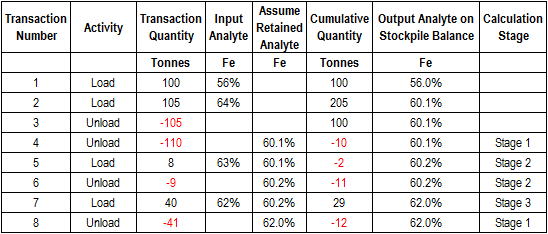Negative Despatch Stockpile Example
Each loadable/unloadable part of a despatch (truck despatch, train wagon or rake, shipment hold, or service trip) is modelled in MineMarket as a moving stockpile.
A negative balance can occur on a despatch stockpile if the sum of the unloading transactions is greater than the loading transactions; for example, because of inaccuracies in measurement equipment.
If the global despatch stockpile settings have Retain State on Negative Balance checked, the calculation of contributor values and analyte quality on negative despatch stockpiles is like the calculations for WAG stockpiles when the Negative Method is Previous Period WAG. However, in Stage 2, a weighted average of all the loading transactions is used, instead of considering only transactions within a specified previous period.
Analyte Calculations
There are three possible stages for the calculation of retained analyte quality on despatch stockpiles that go negative.
Stage 1
If a despatch stockpile goes negative after an unloading transaction, the Assume Retained analyte quality is maintained at the values prior to going negative.
Stage 2
If a new loading transaction occurs but the stockpile balance stays negative, the Assume Retained analyte quality of the stockpile balance is assigned the weighted average of the analytes from all the loading transactions.
Stage 3
If a new loading transaction makes the negative stockpile balance positive, the new loading transaction analytes are assigned to the stockpile balance.
Example
The following table displays the transactions on a despatch.
Note: Most despatches have only one loading route point and one unloading route point, and therefore will not go beyond Stage 1. The following scenario, with multiple loading and unloading points is unrealistic. However, it is useful to illustrate all the possible calculation stages. The assumption in the scenario is that the unloading equipment is consistently measuring a higher quantity than the loading equipment.

Stage 1 begins with Transaction 4, when the stockpile balance becomes negative. The stockpile's analyte quality for iron was 60.1% after Transaction 3, so that value becomes the assumed analyte value for the unloading transaction in Stage 1.
Stage 2 begins with Transaction 5. Although this is a loading transaction, the quantity is not enough to make the stockpile balance positive. The assumed analyte quality for iron becomes the weighted average of Transactions 1, 2 and 5, which are all the loading transactions:
( 100 * 56% + 105 * 64% + 8 * 63% ) / ( 100 + 105 + 8 ) = 128.24 / 213 = 60.2%
Stage 2 continues with Transaction 6. The unloading transaction assumes the analyte quality from the previous stockpile balance.
Stage 3 begins with Transaction 7, which is the first loading transaction that makes the stockpile balance positive. The sampled analyte quality for iron on that transaction is 62%, and this becomes the analyte value on the stockpile balance.
Transaction 8 is a final unloading transaction to empty the despatch. However, it also returns the stockpile balance to negative. This is a new Stage 1, and the analyte quality is assumed from the stockpile balance after Transaction 7.
Contributor Calculations
There are three possible stages for the calculation of retained contributor values on despatch stockpiles that go negative.
Stage 1
If a despatch stockpile goes negative after an unloading transaction, the Assume Retained contributors are set to the original contributors for the current and any subsequent unloading transactions.
Stage 2
If a new loading transaction occurs but the stockpile balance stays negative, the Assume Retained contributors are calculated as the weighted average of the contributors from all the loading transactions.
Stage 3
If a new loading transaction makes the negative stockpile balance positive, the new loading transaction contributors are assigned to the stockpile balance.
Example
The following table displays the transactions on a despatch.
Note: Most despatches have only one loading route point and one unloading route point, and therefore will not go beyond Stage 1. The following scenario, with multiple loading and unloading points is unrealistic. However, it is useful to illustrate all the possible calculation stages. The assumption in the scenario is that the unloading equipment is consistently measuring a higher quantity than the loading equipment.

Stage 1 begins with Transaction 4, when the stockpile balance becomes negative. The stockpile's contributor values were A:49% and B:51% after Transaction 3, so those values become the assumed contributor values for the unloading transaction in Stage 1.
Stage 2 begins with Transaction 5. Although this is a loading transaction, the quantity is not enough to make the stockpile balance positive. The assumed contributor values become the weighted average of Transactions 1, 2 and 5, which are all the loading transactions. For Contributor A:
( 100 * 100% + 105 * 0% + 8 * 0% ) / ( 100 + 105 + 8 ) = 100 / 213 = 47%
Stage 2 continues with Transaction 6. The unloading transaction assumes the contributor values from the previous stockpile balance.
Stage 3 begins with Transaction 7, which is the first loading transaction that makes the stockpile balance positive. The sampled contributor values on that transaction are A:100% and B:0%, and these become the contributor values on the stockpile balance.
Transaction 8 is a final unloading transaction to empty the despatch. However, it also returns the stockpile balance to negative. This is a new Stage 1, and the contributor values are assumed from the stockpile balance after Transaction 7.
